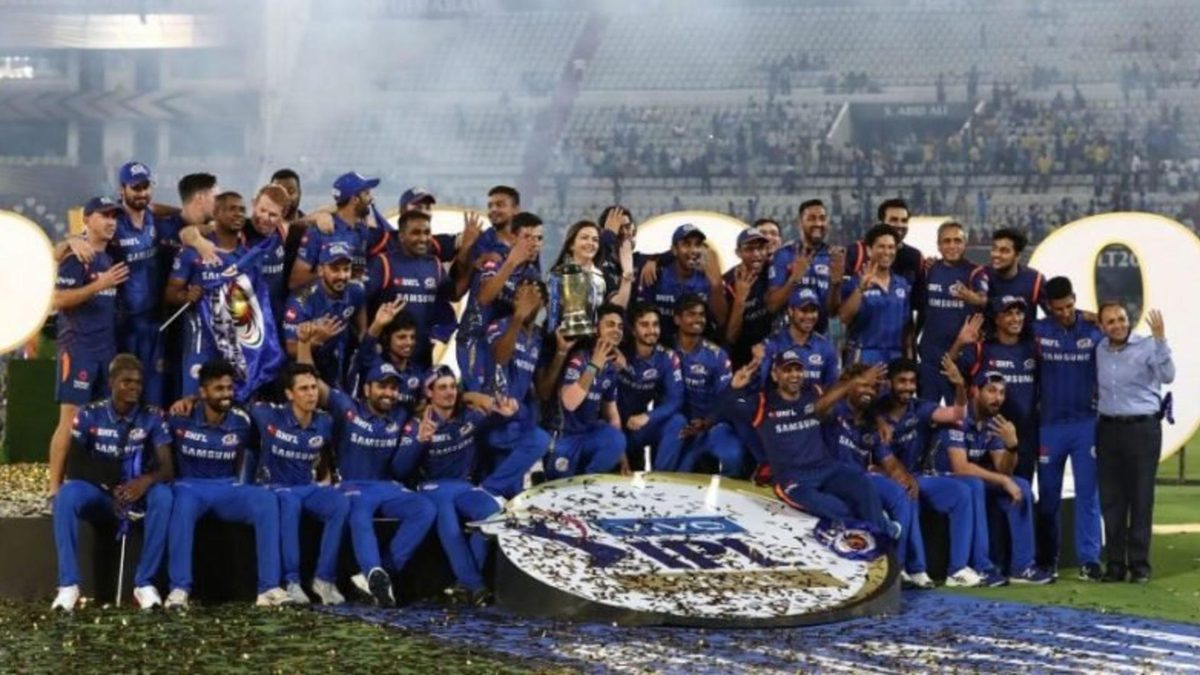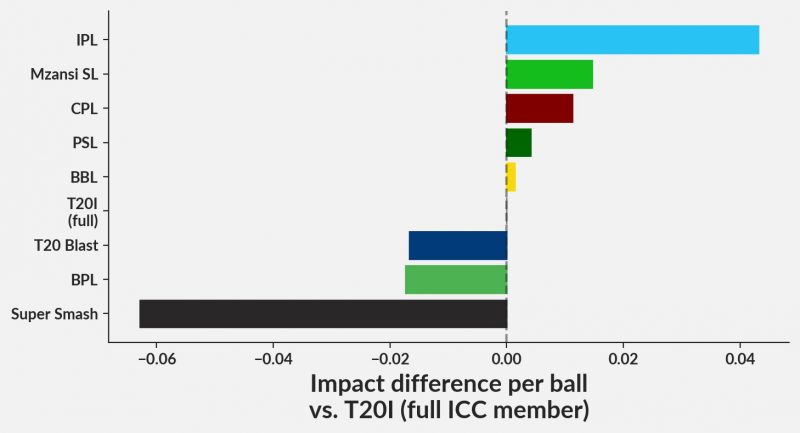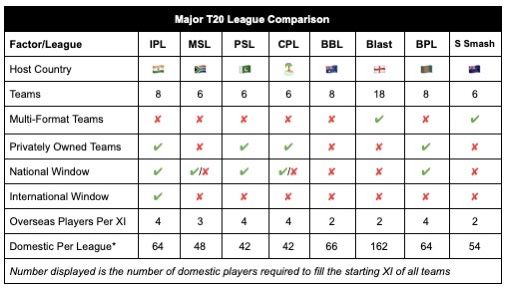
A common challenge in sports analysis is assessing and comparing performances in different settings and competitions around the world. Just as scoring a fifty in the garden or taking a five-for on a maidan does not make you a better player than a Test batsman who scored a duck or took no wickets, the same applies for professional players in different leagues and competitions as well.
CricViz analyst Freddie Wilde sheds light on CricViz’s advanced analysis of the different standards of T20 cricket around the world.
The common problem
Not all teams and certainly not all leagues are of equal standard and identifying exactly to what extent they are different is a central challenge involved in inferring a player’s ability. This has enormous implications for player recruitment and selection at domestic and international level.
The T20-specific issues
This challenge is particularly acute in the T20 format. At domestic level, the advent of drafts and auctions across the last decade and the greater multi-national movement of players around the world has increased the importance of accurate assessment and valuation of players. While at international level, having historically made selections based almost entirely on performances in a single first-class or List A competition which facilitated comparison, now selectors are having to evaluate performances from multiple competitions with vastly different standards.
Data analysis
Using data it is possible to quantify the differences in standard of T20 cricket played around the world which then enables us to adjust player data accordingly.
The methodology for this is fairly straightforward: we look at all the players who have competed in multiple tournaments around the world and assess how their performances have changed accordingly. For example, if a Sri Lankan batsman dominates in their state competition but then struggles in the Pakistan Super League (PSL) we can infer that the PSL is of a higher standard than the Sri Lankan competition or if an English bowler has struggled in the Indian Premier League (IPL) but succeeded in the Blast then we can infer the IPL is a higher standard than the Blast.
Across sample sizes such as these it can be difficult to be confident in these figures but as we add more and more players into this we can become increasingly confident in the outputs. The model uses our advanced Match Impact model which adjusts for conditions, venues and match situations as its baseline and now has 4,500 players worth of data factored in.
The findings of this model are displayed in the chart below, with the one caveat that with just one season of Mzansi Super League data we expect that its current ranking is partly a product of its small sample size. That said, for reasons we will explore later, there are plenty of decent arguments for it being regarded as a competition with a pretty high standard.

The international question
The most significant takeaway from the data is that international cricket is not the highest standard of T20 cricket. This is a very unfamiliar concept for cricket to come to terms with. Historically the sport has been based around nation v nation contests that have seemingly represented the pinnacle of the sport.
It is important to recognise that the figure displayed here for T20 internationals is the average of all T20 international cricket played between ICC Full Member nations, so it includes matches between Zimbabwe and Afghanistan as well as matches between India and Australia, for example. The standard of international cricket varies significantly according to which country is playing but taken as a whole, the average match between two Full Member nations is of a lower standard than five of the world’s domestic leagues.
The factors that influence the standard of international teams are more straightforward than those influencing domestic leagues. Broadly speaking there are two primary considerations. The first and most important is simply the domestic talent pool. International teams are only able to select players who are qualified citizens of their country. Unlike domestic teams they do not have to compete with other teams for these players, however unlike domestic teams they are not able to supplement these players with overseas signings.
This is a hugely significant factor in why some T20 leagues are able to produce a higher standard of cricket than T20 internationals because this process enables domestic teams to bolster traditional areas of weakness in the domestic talent pool. For example, in the PSL teams stock their bowling with domestic pace bowlers – a traditional area of strength in Pakistan – and use their overseas spots to strengthen their batting where there are far fewer elite domestic batsmen. If international sides were able to do this we would see far more rounded teams at international level.
[caption id=”attachment_147877″ align=”alignnone” width=”800″] For a number of reasons, CrIcViz rate T20 Blast as being far from the world’s best[/caption]
For a number of reasons, CrIcViz rate T20 Blast as being far from the world’s best[/caption]
International teams are very much at the mercy of their own domestic talent pool and while they can do things to strengthen this around infrastructure, coaching and facilities their broader scope is largely determined by very macro factors such as population size, the popularity of cricket and indeed the overall wealth of the country.
In recent years international teams such as South Africa and West Indies have begun to face an additional challenge to their domestic talent pool with some of their best players turning their backs on international cricket to free themselves of bilateral commitments and play more domestic T20. In the case of the West Indies this is particularly problematic for assessing their standard of T20 cricket because their best T20 players typically return for World Cups but very rarely play in bilateral series.
The second, smaller, factor that influences the standard of international T20 cricket is that international teams are not only focussed on one format. Unlike multi-format domestic teams such as those in England or New Zealand, for example, international teams can at least select entirely different squads for different formats. However, total disassociation of the formats is difficult to achieve. For example, international contracts are generally awarded across all formats or at best split in terms of red and white-ball and these contracts do play a role in selection in T20.
A player with a national contract is probably slightly more likely to be selected for the T20 squad even if he is less suited to the 20-over game than a rival for his spot who is a T20 specialist who doesn’t have a national contract. Similarly international teams have by and large not adopted split coach models which means head coaches are appointed based on their credentials across all formats, while specialist T20 teams can appoint coaches and entire backroom staff based only on their 20-over reputation and with only one format to concentrate on. These factors are only marginal but they are likely to have a deleterious effect on the quality of international T20 played.
Ultimately the most important thing to recognise is that international cricket taken as a whole demonstrates wildly fluctuating standards depending on who is playing and analysis should reflect this accordingly. As with leagues, CricViz also adjusts performances by international opponent with Australia, India and England currently way out in front as the world’s strongest international teams, ahead of the West Indies who are themselves ahead of the chasing pack. A century against Zimbabwe is not worth as much as a century against India, for example, and our numbers seek to reflect that.
New trumps old
The second major takeaway from the data is that newer, specialised T20 leagues — the IPL, Mzansi Super League (although a small sample size of only two seasons may explain its high rank) PSL and Caribbean Premier League (CPL) — come out relatively well, while leagues competed for by older state or county teams come out less favourably. The rest of this article will seek to explain why this pattern can be discerned.
Broadly speaking there are six primary factors that influence the standard of T20 cricket played in domestic T20 leagues:
- Number of teams
- Team purpose
- Team ownership
- Domestic talent pool
- Overseas talent pool
- Player contracts and distribution
Number of teams
The number of teams in domestic T20 leagues around the world ranges from 38 in India’s Syed Mushtaq Ali Trophy to just six in the MSL, CPL, PSL and New Zealand’s Super Smash. The more teams there are, the more thinly spread the talent pool is and the more dependent the league’s standard will be on the depth of that talent pool.
Generally speaking therefore – and this is not a fixed rule, but a clear trend – the more teams there are; the lower the standard of cricket. This is one of the major reasons why the T20 Blast (18 teams) is ranked relatively low and why the IPL (eight teams), MSL, PSL and CPL (six teams) are ranked relatively high.

Team purpose
There is one very fundamental difference between domestic T20 teams around the world and that is that some are specialist T20 teams that only play T20, while some are multi-format teams who play in first-class and List A competitions as well.
Until 2008 all domestic T20 leagues were competed for by teams who also played first-class and List A cricket. However, since the advent of the IPL in 2008, more and more leagues have been established with teams who only play T20. Now, among the major leagues the teams in the IPL, Bangladesh Premier League (BPL), CPL, PSL and MSL are all specialist T20 teams; while those in the T20 Blast, Super Smash and India, Pakistan and Sri Lanka’s state competitions are multi-format teams.
There are benefits to both systems. On the one hand the teams that exist year round and play multiple formats may be likely to have better infrastructures in place with academies, coaching systems and youth networks in the local community. On the other hand these teams are forced to build squads to compete in multiple formats which significantly dilutes their T20 ability. Unlike multi-format teams, specialist T20 teams will not have to award contracts to players who are ill-suited to the T20 format and can build a squad and back-room staff entirely of T20 specialists.

In recent years specialised T20 teams have begun to catch up with multi-format teams in regards to infrastructures as well. For example, last year Kolkata Knight Riders opened an academy – the first of its kind in the franchise world – Mumbai Indians have an extended scouting network and various PSL teams have major talent identification programmes.
Overall, the evidence suggests that teams with a specialised T20 purpose are likely to produce a higher standard of cricket.
Team ownership
Economics obviously plays a significant role in the standard of cricket among different teams and leagues. Generally speaking, the richer the team, the higher the quality of players they can attract and the higher the standard of cricket they produce.
The wealth of teams is largely determined by two things: their ownership structure and the overall wealth of their respective board and league. In the IPL, BPL, CPL and PSL, teams are privately owned while teams in the MSL, T20 Blast, Big Bash League (BBL) and Super Smash are largely centrally funded by the national board. The wealthier the national board, the wealthier these teams typically are and the more money they can spend on players.

Generally, but not entirely, privately owned teams pay significantly higher salaries than centrally funded teams. This gulf is most clearly illustrated by the clash between the BPL and BBL that has occurred in recent years. Both leagues have been staged around the new year period and BBL clubs have consistently lost out to the BPL in battles to sign major players with the primary reason appearing to be the significant difference in player salaries.
Domestic talent pools
All domestic leagues exhibit restrictions on the talent pool available to teams via the number of overseas players permitted in each squad and each team. No league allows more than four overseas players per starting XI meaning more than half of all domestic T20 teams must comprise local players. This places huge importance on the quality and depth of the domestic talent pool.
The quality of the domestic talent pool varies massively country to country, depending on a wide range of factors from population size to the popularity of cricket in the country, to the country’s sporting infrastructure (which is tied to wealth) and cricket culture.
India, for example, with a population of more than one billion people and where cricket is the country’s most popular sport are better placed than, say, New Zealand where their population is only a fraction of the size and rugby is the country’s national sport. However, Bangladesh has around 100 million more people than England and 125 million more than Australia but their coaching, facilities and funding are unlikely to be as professional as England’s or Australia’s who both have far richer national boards.
[breakout id=”0″][/breakout]
Culture and playing style is also relevant: the population of the Caribbean is tiny compared to, say, Pakistan but historically the Caribbean has proven far more effective at producing big-hitting, powerful batsmen than Pakistan who have been more effective at producing pace bowlers. These factors all coalesce to produce varying standards, strengths and weaknesses among the domestic talent pool.
A hugely significant factor influencing the quality of domestic players available to teams in leagues is whether or not the host country creates a window in their national schedule to enable their best players to play in the league. Among the major leagues neither Australia or England currently do this meaning many of their country’s best players are often on international duty while their league is going on.
For some of cricket’s poorer countries: South Africa, New Zealand and West Indies, whether they can make their international players available for their domestic leagues can be dependent on the vagaries of the Future Tours Programme. Of course, ideally boards would find an international window to allow their best players to appear in the league but if they are due to tour somewhere – particularly profitable tours against Australia, England or India – they generally have to make exceptions.
India, Bangladesh and Pakistan have always established windows in their international calendars to ensure their international players are available for the IPL, BPL and PSL respectively.
The domestic talent pool is one area where the MSL – which comes out very favourably by our model – has done quite well. In the second season in particular the league benefitted from good availability of South Africa’s international players, in addition to some excellent overseas signings too.

Typically whether a national board creates a window in the calendar for their league has been strongly correlated with whether the league has a private ownership model: investors are unlikely to be keen to inject cash into a league if it is perceived to be a secondary priority to international cricket.
Overseas players
Unlike international teams, domestic sides are able to supplement their domestic talent pool with overseas players. The depth of quality of these overseas players varies from league to league depending on three primary factors: the wealth of the teams, the availability of overseas players and the number of overseas players permitted per squad and per team. All of these factors are in some way related to one another.
[breakout id=”1″][/breakout]
The IPL – easily the world’s richest T20 league – commands such a financial pull on the world’s best players that a de facto window for all international cricket has essentially been created during the league. Were national boards to refuse No Objection Certificates to their players for the IPL they would risk serious clashes with their players and players’ association. Only England – whose home season clashes with the IPL – occasionally has to withdraw its players from the tournament. The only country whose players are ineligible and unavailable to play in the IPL is Pakistan’s due to the ongoing political tensions between the two countries. Other than this, the wealth of the IPL and the free-market auction system means the league essentially enjoys uninhibited access to the world’s best T20 players.
All the other major T20 leagues who permit overseas players to play in their leagues experience some kind of availability issues around them because no other league has an established window like the IPL because they are unable to match the wealth of the IPL teams.
However, while the other leagues are unable to compete with the IPL’s stellar cast of overseas players due to a combination of money and availability, generally there are plenty of high quality options to ensure all leagues are relatively well stocked. As more and more players become freelancers, freeing themselves of international commitments, this is increasingly the case.

As more overseas players are permitted per team and per squad the standard of cricket rises because in all but the most exceptional cases most overseas signings will be better players than the replacement domestic player who would play instead. It is no surprise that the leagues with privately owned teams and therefore more money to spend – the IPL, BPL, CPL, PSL – all permit four overseas players per team. The MSL is a centrally funded league and permits three overseas players, while the BBL, Blast and Super Smash only allow two. The state level tournaments in India, Pakistan and Sri Lanka do not permit any overseas players and the tournament is entirely made up of local players.
The IPL and BPL’s allowance of eight overseas players per squad is the most of any T20 league. Although only four can play at any one time the ability to call on different players, with different skills and respond to changes in form or conditions by selecting different overseas combinations places is clearly something which elevates the standard of cricket higher still. The PSL allows six, CPL five and MSL four per squad. The T20 Blast and Super Smash allow teams to contract as many overseas players as they want but in reality in England no team ever contracts more than two and sometimes in New Zealand teams sign none at all.

When you combine the number of teams per league and the number of overseas players per league you can identify how many domestic players per league are required to fill each starting XI and the findings are revealing. The T20 Blast stands out as requiring a huge number of domestic players compared to other competitions and the large majority of the time, the Blast is unable to rely on England internationals to bolster the standard.
The BBL faces a similar issue on a smaller scale, although the relative sizes of England and Australia’s professional systems means England naturally has more players to call on. It is no surprise that the MSL, CPL and PSL come out so favourably when they have to rely on a relatively small number of domestic players and they typically have an international window freeing up their country’s best players.

Player distribution
The system used for distributing and contracting players is also a significant driver of standard of cricket among leagues. Shorter-term contracts with drafts and auctions are generally best for the standard of cricket. The primary reason for this is that talent is forced to be relatively evenly distributed rather than teams ‘hoarding’ talent in their squads but not playing them.
Auctions and drafts are very similar but generally the auction, used only in the IPL, is marginally better for the standard of cricket than drafts, used in the BPL, CPL, PSL and MSL, because teams can pay exactly what they determine a player to be worth rather than be hamstrung by the predetermined salary bands used in drafts. However, even in the IPL auction players must submit a ‘base price’ – the lowest salary they are willing to accept which can see some very good players unsold, but the larger salary cap means this occurs less often in the IPL than it does in poorer drafts where players are less willing to drop their base price into lower bands.
The most rudimentary system for allocating players is traditional contracting: this is when negotiations between player and team occur in private and when contracts can last many years. This system, used in the BPL, BBL, T20 Blast and Super Smash, can see talent less evenly spread among the teams, leading to some good players not able to play so regularly.
Conclusions
Having gone through the factors likely to affect the standard of T20 cricket it is difficult to disagree with the findings of the model.
The discrepancies between some international teams and the world’s best T20 leagues are – although perhaps surprising at first – logical. International teams are entirely restricted by their domestic talent pool while domestic teams enjoy access to overseas players and the ability to fill very specific team shortcomings with those players.
Among domestic leagues the triumph of new-age structures also makes sense: ultimately fewer, specialised T20 teams, private ownership, a strong domestic talent pool, good access to high quality overseas players and systems of drafts and auctions are all likely to produce higher standards.

The IPL is richer than any national board except the one which owns it, while the CPL and PSL can call upon exceptional local talent dispersed among six teams and supplement them with outstanding overseas players of their choosing. The T20 Blast, on the other hand, may be the world’s oldest T20 competition but it is far from the best. The large majority of the justifications for The Hundred – England’s new short-form competition – have been off the pitch but this data suggests that England is in dire need of a new tournament to support their short format cricket on the pitch as well.
From the rise of power-hitting, to the growth of 360° scoring, to the success of mystery spin – T20 has overturned conventional wisdom and tradition at almost every turn. The rise of the supranational T20 league – not only off the pitch – but on it as well, is yet another chapter in this story.







